Sussex Women at War: Iva Mary Harland and Fanny Amelia Kennaird
- Home
- World War I Articles
- Sussex Women at War: Iva Mary Harland and Fanny Amelia Kennaird
The Great War is seen as an event that marked and occasioned deep and lasting social change. Historians might argue as to the scale or extent of its effect, but it cannot be denied that post-war Britain was a very different place from that which existed in the idyllic summer of 1914. All aspects of life were affected including the class system, religion, politics and work, and along with the acceleration in medical, scientific and technological advances driven by the hothouse atmosphere of war– all coalesced to form a progressive agenda. One of the most profound changes was that of the role and status of women, particularly working-class women.
The war saw significant growth in women’s employment, and one of the main causes was the introduction of military conscription in 1916. As the men left the factories for the front, women replaced them in large numbers. This was vital for the war effort, especially in the munitions industry. The statistics show a 100% increase following conscription.
Date Women employees (munitions)
July 1914 212,000
July 1915 256,000
July 1916 520,000
July 1917 819,000
The figure overall in traditionally male dominated occupations increased exponentially: ‘in industry as a whole the total employment of women and girls over ten as between 1914 and 1918 increased by about 800,000, from 2,179,000 to 2,971,000’ [1]. In the transport sector the number of women employees jumped from 18,000 to 117,000 over the course of the war, and in the public sector ‘198,000 women entered the Government and Local Government offices, as clerks, shorthand typists, supervisors, welfare workers and interpreters’[2]. It was only in the field of domestic service – the traditional career for working class girls – that the figures decline: ‘from 1,658,000 in 1914 to 1,258,000 in 1918’ [3], a decrease of 400,000.
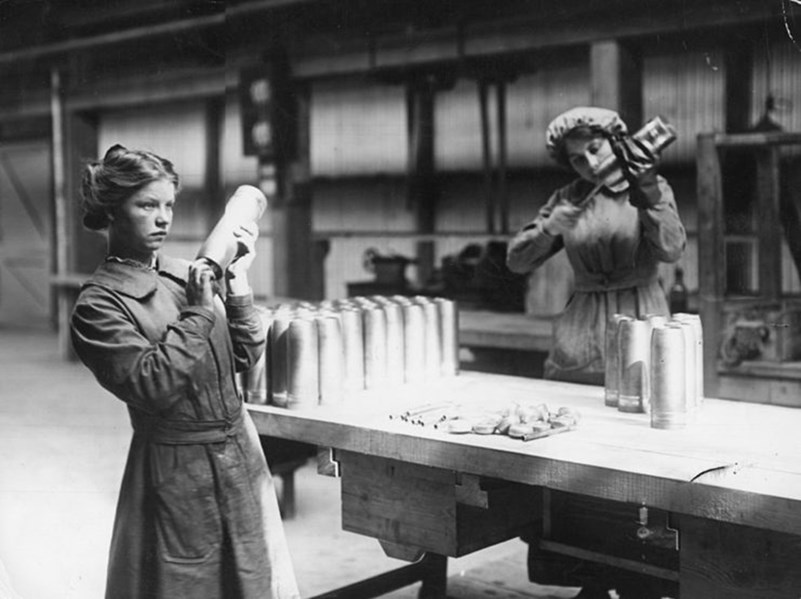
Above: Munitionettes: The Women who built munitions during WW1
The army, the most entrenched of male dominated occupations, was no exception. Initially there was resistance, it was thought that women possessed neither the ability nor the resilience to perform military roles in any capacity, but the army finally accepted that by employing women in support roles more men were freed up for front line duties. Consequently, ‘by the end of 1916 a fair variety of women’s paramilitary organisations had sprung up, consolidated by the Government at the beginning of the following year into the Women’s Army Auxiliary Corps (WAACS); there followed the WRENS and the WRAFS, all providing for adventurous women an opportunity for overseas travel and service hitherto denied them’ [4].
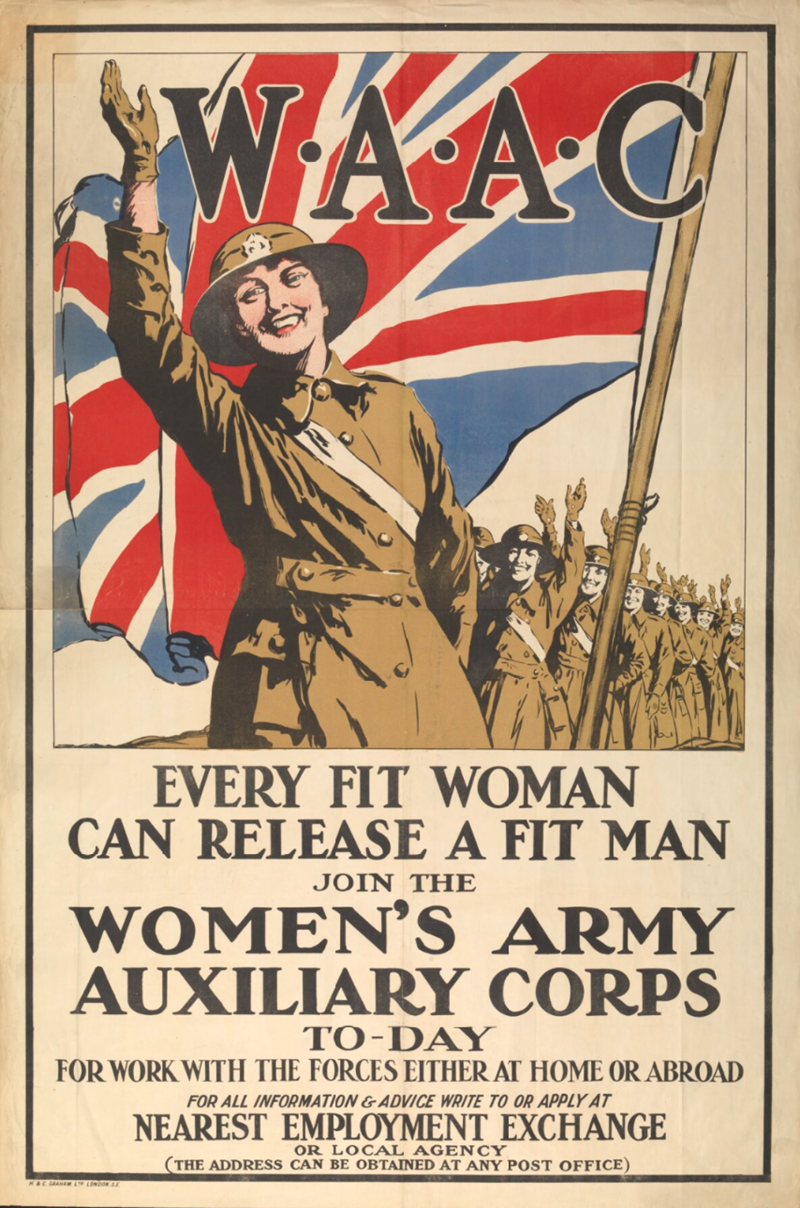
Above: Recruitment poster for the WAAC © IWM Art.IWM PST 4881
The Women’s Army Auxiliary Corps (WAAC) was formally established on 7 July 1917 with Dr Mona Chalmers Watson appointed as Chief Controller. The corps was restricted to duties that fell under the following four categories: clerical, cookery, mechanical and miscellaneous. They were issued with khaki-coloured uniforms comprising a soft brimmed hat and a gaberdine coat frock (the hemline no higher than 8 inches from the ground). Daily physical exercise was compulsory. The higher ranks, equivalent to the Army’s officer class, were controllers and administrators, the NCO’s counterparts were forewomen, and the lower ranks were titled members or workers. Initially confined to service at home, they were soon deployed in France and Helen Gwynne-Vaughan was appointed Chief Controller Overseas. The performance of the WAAC during the German Spring offensive of 1918 so impressed Queen Mary she became their patron, and the corps was renamed the Queen Mary’s Army Auxiliary Corps on 9 April 1918 (QMAAC).
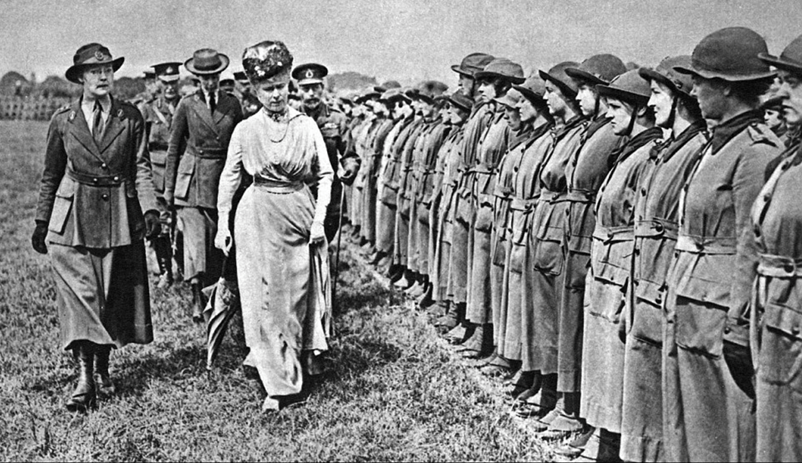
Above: Queen Mary inspecting members of the WAAC at Aldershot barracks in 1917. (Image – The Royal Collection Trust)
Enrolled women of all classes benefited in various ways. What all of these social groups had in common was that, for the first time, young single women, cut free from patriarchal systems and economic dependence were earning their own income, and living away from home were able to socialise without chaperones, enjoying a fully independent life. In short, it was a form of emancipation. For the lower classes in particular, it was an ‘escape from ill-paid life-diminishing drudgery as dressmakers and domestic servants or low-grade industrial labour into work which gave both economic status and a confidence in the performance of tasks once the preserve of skilled men’[5].
But the formation of the WAAC was not universally welcomed by society, one objection was that the corps ‘was aimed primarily at working class women and during the war this group was viewed with increasing suspicion and dislike by some in the middle classes. They were gaining greater independence as they moved into men’s jobs and their wages were increasing. Concerns were raised about their new lifestyles, which were described in contrast to the life of the men in the trenches who were fighting to protect those very same women. This was particularly the case for the munitions workers who were often depicted as immoral, drunk and spending their money on luxury goods. This led to questions about the real motivation for women wanting to join the army, i.e., that it was not for patriotic reasons, but for independence and money’ [6]. However, this view is not entirely borne out by the evidence, many of those that served were asked in their later years why they joined: ‘patriotism is the reason most often given by the women’ [7], although other reasons included ‘a desire for adventure, a sense of belonging, freedom and independence’ [8].
Two of those that answered the call were Worker Iva Mary Harland and Member Fanny Amelia Kennaird.
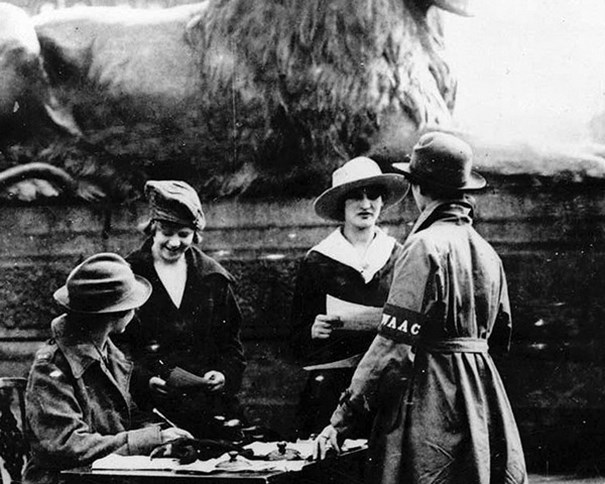
Above: Enrolling new recruits to the WAAC, 1917 (Image – National Army Museum)
Worker 34544 Iva Mary Harland, QMAAC
Iva was born in the last quarter of 1895 to George Harland, 1873-1959, a roadman employed by the Rural District Council, and Mary Elizabeth (née Godfrey), 1871-1949, in the parish of Framfield, Sussex. She was their firstborn child and was baptized on 26 January 1896. The 1901 census shows the family living at Blackboys, Framfield, listed as Head: George Harland age 27, Wife: Mary E Harland age 29, Iva M Harland age 5, Scholar, Alice L Harland age 2. Her brother, William George Harland, was born in 1905 (William died in the Second World War in 1941 whilst serving with the Royal Army Service Corps aged 36). By the time of the 1911 census, at 15 years old, Iva has moved out of the family home, having secured employment as a live-in domestic servant with Frances Theresa Blythe (aged 61 in 1911), head of the household and a woman of ‘private means’, and her brother Arthur John Dalziel Blythe (aged 63 in 1911), formerly an accountant, at Willingdon Road, Eastbourne, Sussex.
Iva was one of those who swapped life ‘below stairs’ for khaki, joining the mass exodus of chambermaids, scullery maids, children’s nurses, washerwomen, cleaners and other varieties of maidservant that saw a way out from a life of servitude. No more kowtowing, bowing and scraping or the submissive averting of eyes in the presence of one’s master or mistress, joining the WAAC became an act of validation, of building self-confidence and a sense of self-worth.

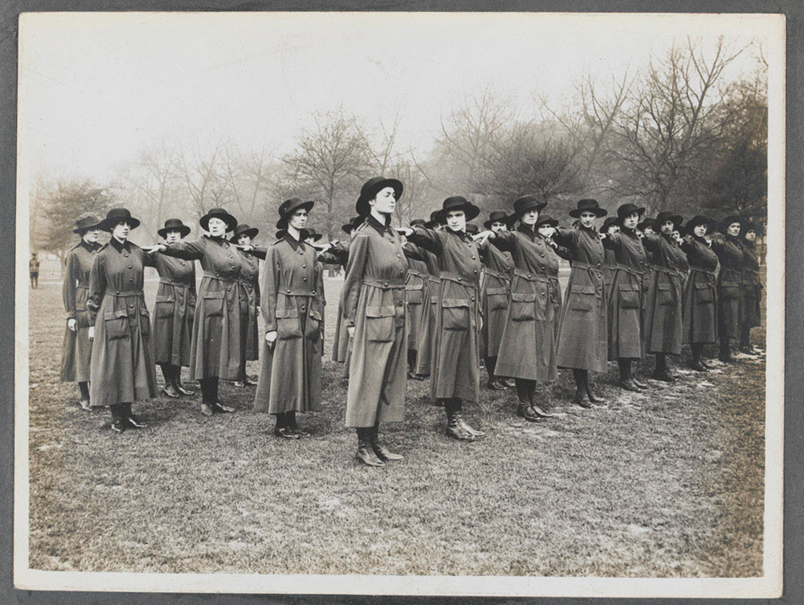
Image: ‘Women's Army Auxiliary Corps drilling, 1917 (c) [Image number: 111229].
Unfortunately, details of Iva’s service with the WAAC appear to have been lost in the fire at the War Office Record Store, Arnside Street, Walworth, in 1940, the warehouse badly damaged as a result of a German air raid. What is known is that Iva’s service ended with her death on 28 February 1919at the age of 23. The Church of England’s Death and Burial Index lists her last known address as the Women’s Isolation Hospital, Aldershot. She was buried at St Thomas á Becket Church in Framfield, Sussex, laid to rest in the northeast corner of the graveyard. The inscription on her headstone reads as follows:
In
Loving Memory
Of Iva Mary,
Beloved Daughter Of
George and Mary Harland,
Of Black Boys,
Queen Mary’s Army Auxiliary Corps,
Who Died
At Mandora Hospital Aldershot,
28th February 1919
Aged 23 Years
Peace Perfect Peace
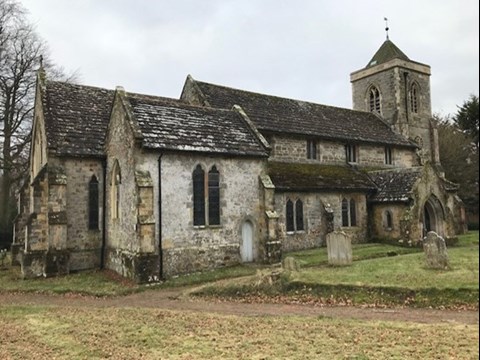
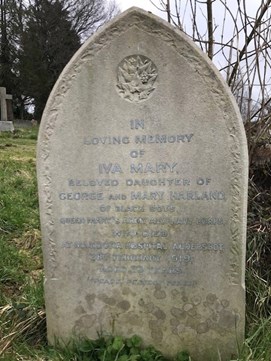


Above: St Thomas á Becket Church, Framfield, East Sussex and the headstone of Worker 34544 Iva Mary Harland, QMAAC (Photos – Paul Blumsom)
Member 7396 Fanny Amelia Kennaird, Women’s Royal Air Force, formerly 18843 Women’s Army Auxiliary Corps
Fanny was born in the first quarter of 1898 at Ticehurst, Sussex, to Job Alexander Kennaird, 1860-1914, a Domestic Gardener, and Fanny (née Stevens), 1878-1936. The 1911 census shows the family living at Cousley Wood, Wadhurst, Sussex. Fanny aged 13 is the eldest child, followed by four brothers and a baby sister: William aged 10 (William’s twin brother, Job, died in infancy), Henry aged 8, (Stephen) John aged 8, Benjamin aged 5 and Evelyn aged2.
Fanny joined the WAAC on 13 December 1917 at 2 Hyde Park Street, London and her service record shows she moved into a hostel in the metropolis on 17 December 1917. She joined as a cook, was classified as Home Service only, and allocated service number 18843. In addition to army establishments, members of the WAAC served at air stations and depots for the Royal Flying Corps (RFC). On 5 March 1918, Fanny moved into a different hostel at Warwick Square, Pimlico, and its proximity to the RFC’s Number 4 Aircraft Repair Depot in Ebury Bridge Road, Pimlico, suggests she was stationed there.
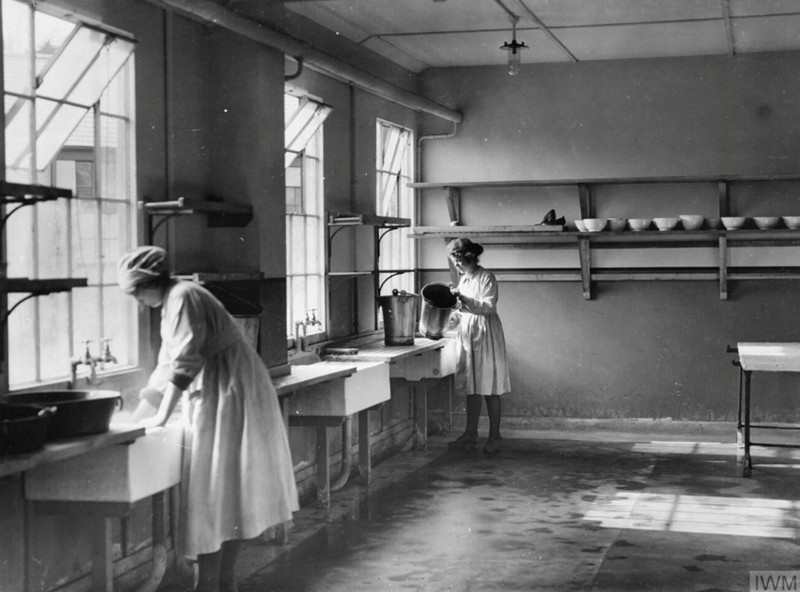
Above: ‘WRAF cooks in the scullery of a WRAF hostel at Uxbridge.’ © IWM Q 72679
When the Royal Air Force (RAF) was formed as a result of the merger of the RFC and the Royal Naval Air Service (RNAS), the personnel of the WAAC that were attached to the RFC, and those of the Women’s Royal Naval Service (WRNS) similarly posted to the RNAS, were given the choice of transferring to the newly established Women’s Royal Air Force (WRAF). Fanny was one of the 9,000 who chose to do so. Her service record shows that she transferred from the WAAC to the WRAF on 1 April 1918, the exact date that the new corps came into being, and allocated service number 7396.The WRAF divided their personnel into two categories, the Immobiles’, who lived at home and were stationed locally, and the Mobiles’, who were required to live on or near their workplace away from home. Fanny clearly fell into the latter category.
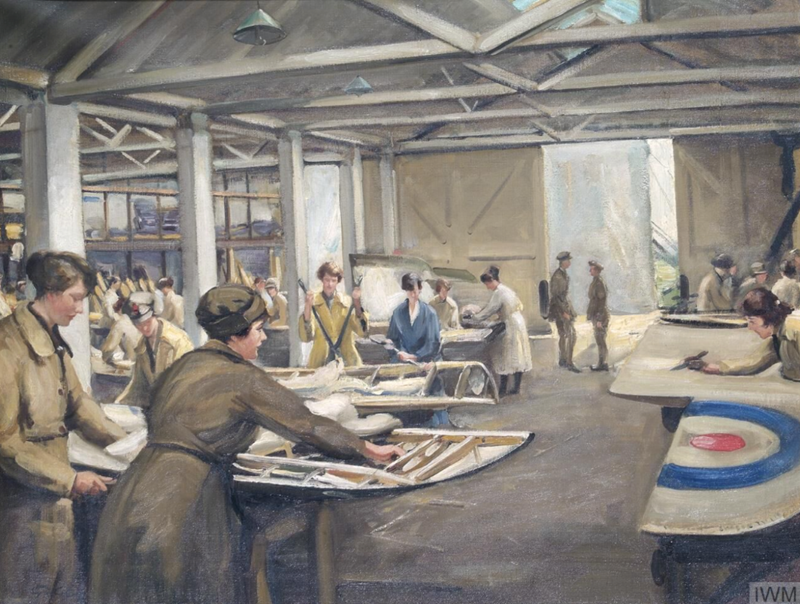
Above. No 1 (Southern) Farnborough: WRAF at work on aeroplane salvage © IWM Art.IWM ART 2459
Like Iva, Fanny was in her early 20’s when her service ended with her death. She died on 14 January 1919 at the age of 21. She was buried at St Peter and St Paul Church, Wadhurst, on 18 January 1919.

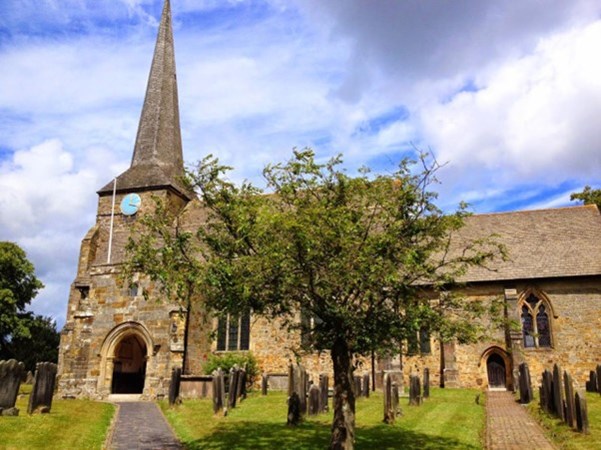
Above: St Peter and St Paul Church, Wadhurst, East Sussex (Image – explorechurches.org)
Iva and Fanny died within weeks of each other in the winter of 1919. Both were young, fit and healthy. When considering the cause of death, one need look no further than the Spanish Flu epidemic of 1918/19. One of the deadliest – if not the deadliest – global pandemics in history, the Spanish Flu had a disproportionately high mortality rate for young adults, unlike most influenzas that affect the very young and the old. The death rate globally is estimated at between 17 to 50 million, possibly as high as 100 million, in Britain it ‘reached its peak in 1919 […] about 20 per cent of Britons were affected, with a death toll of 228,000’ [9].
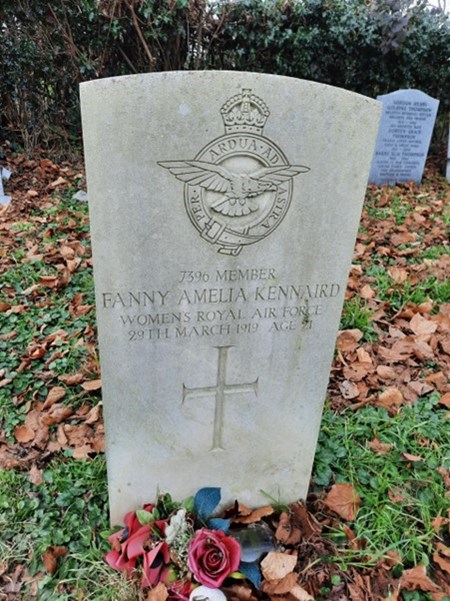

Above: Headstone of Member 7396 Fanny Amelia Kennaird, WRAF – the date of death has been inscribed in error and should read 14th January 1919 (Photo – Andrew Minns)
The service that Iva and Fanny gave, and that of all their sisters serving and working across the country and abroad, whether supporting the armed services or in civilian occupations, was essential to the war effort. Their contribution was recognised by politicians of all persuasions and would have far-reaching consequences. The question of women’s suffrage, held in abeyance from the commencement of hostilities (the suffragettes and the suffragists had suspended their activities in the national interest), arose organically, almost unbidden, half-way through the war. Resistance to the enfranchisement of women crumbled, and even the most traditional of opponents were convinced of the need for change. In an obituary of Colonel Dudley Sampson JP, a local Sussex notable, published in February 1917, it was observed that Colonel Sampson was ‘a staunch conservative, and although opposed to women's suffrage prior to the War, he came to see later that the good service rendered by women to the country made them worthy of the vote’ [10].
The Prime Minister, David Lloyd George, was, much more than his predecessor Herbert Asquith, sympathetic to the cause, and in a newspaper article headed THE PREMIER AND WOMEN’S SUFFRAGE: REPLY TO A DEPUTATION, it was reported that he came out unequivocally for women’s suffrage:
Replying yesterday to a deputation representative of women’s work in all trades, professions, and occupations, on the question of the enfranchisement of women, Mr. Lloyd George said one thing that would emerge from the horrors of the war would be the conviction that women must be admitted to complete partnership in the government of the nation [11].
Subsequently, the legislature passed a bill preparatory to enfranchisement. It was reported across the nation thus:
By a majority of 330 (385 votes to 55) the House of Commons has signified its assent to the principle of votes for women. Since the war opinion on this subject has undergone a remarkable change, and whereas Parliament prior to the war in two consecutive years thought it inadvisable to grant the franchise to women the same Assembly has now approved of it in a most decisive manner. The women of the country have played a noble part in the war, and their ability and energy have paved the way for their victory in the political arena. In the days of militancy many believers in the cause were alienated by the methods employed, but subsequent events have proved the fitness of women to take a more active share in the affairs of the nation [12].
That Iva and Fanny had a sense of adventure is clear. These intrepid, spirited young women, not only helped win the war, but were instrumental in advancing the cause for women’s suffrage. What they both had in common was that they were firstborn children, and this might be particularly pertinent in their trailblazing decision to enrol. Joining the WAAC was a bold statement of intent, often such a move was made against their parents’ wishes. The eldest girl in a working-class family was often required to adopt the role of the ‘little mother’, looking after her younger siblings to ease the burden: ‘an eldest daughter would often have the additional assignment of acting as nursemaid to her youngest brother or sister, or of undertaking a week’s shopping if her mother were ill or confined with the birth of yet another child’ [13]. The responsibility thrust upon such girls caused them to grow up fast and develop a resilience, and a capability, that would equip them well for service life. Born, bred and buried in their respective corners of the Weald, 15 miles apart, Iva and Fanny could have seen out the war in sleepy Sussex, but they chose to serve, and died in the course of doing so. The impact that they and their sisters-in-arms had was seismic, in Lloyd George’s words:
This war was begun in order that force and brutality might crush out freedom among men. Its authors cannot have foreseen that one of its main effects would be to give to women a commanding position and influence in the public affairs of the world. To their ennobling influence we look not only for strength to win the war but for inspiration during the great work of reconstruction which we shall have to undertake after victory is won.
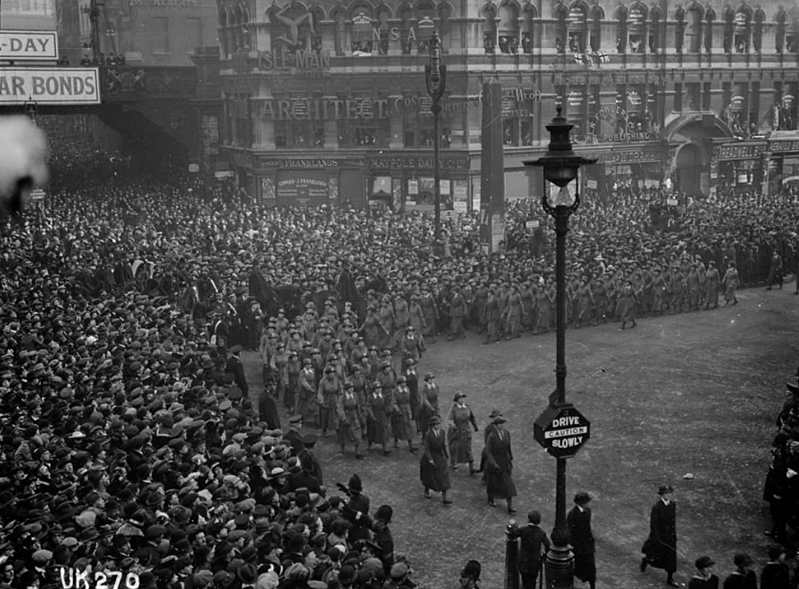
Above: The Women’s Army Auxiliary Corps marching marching in parade in Ludgate Circus, London at the end of the First World War. (Public Domain MediaDrumWorld)
The post-war landscape is also referred to by the anonymous author of a previously unpublished manuscript unearthed from the Imperial War Museum’s department of printed works rare book collection, who states:
The women learned a great deal from their war service, of whatever kind, and it did more than release the energies of British women – it helped to draw them nearer to their sisters in other lands, especially those who went through the same terrible years of anxiety and trial in the Allied Nations. They learned discipline and loyalty to an ideal, and if it brought them much sorrow, it brought them a wider freedom than they had ever known before, and opened to them the gates of opportunity and service, so that life will never be the same for women as it was before 1914, certainly not for the generation which went through and survived that ordeal by fire – and for the generations to come, though they may not understand and appreciate the fact, that freedom which was won for them was won by the unselfish service and sacrifice of the women for whom the Great War altered the whole face of the world and their own lives [14].
Such is Iva and Fanny’s legacy.
Article by Paul Blumsom
References
- Marwick, Arthur, The Deluge: British Society and the First World War, Macmillan, London, 1978, p.91.
- Anon, British Women’s Work during the Great War (with a list of women who died on war service), Naval & Military Press Ltd, Uckfield, East Sussex and The Imperial War Museum, Department of Printed Books, London (facsimile reprint), p.20.
- Marwick, p.92.
- Marwick, p.93.
- Marwick, p.94.
- Philo-Gill, Samantha, The Women’s Army Auxiliary Corps in France 1917-1921: Women Urgently Wanted, Pen & Sword, Barnsley, South Yorkshire, 2017, p.36.
- Philo-Gill, p.37.
- Philo-Gill, p.37.
- Hutton, Mike, 1919 A Land Fit for Heroes: Britain at Peace, Amberley Publishing, Stroud, Gloucestershire, 2019, p.30.
- Sussex Express dated Friday 23 February 1917, p.8.
- Sussex Daily News dated Friday 30 March 1917, p.4.
- Dundee Courier dated Wednesday 20 June 1917, p.2.
- Meacham, Standish, A Life Apart: The English Working Class 1890-1914, Thames and Hudson, 1977, p.162.
- Anon, pp.26-7.





